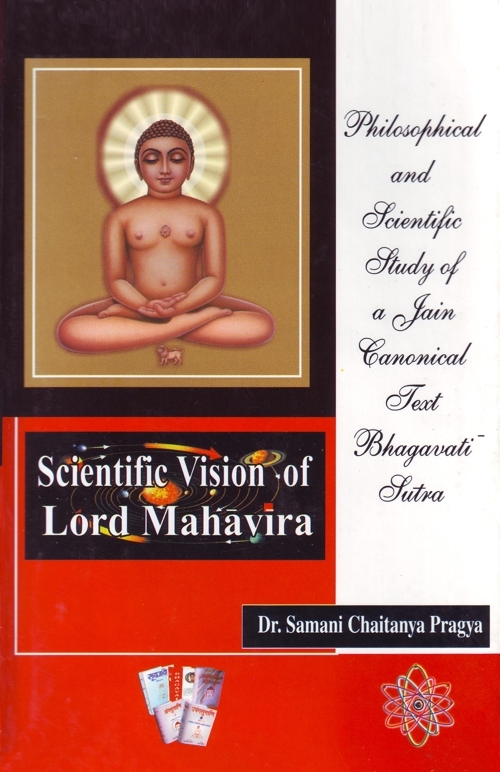Apart from the afore-said qualities, Pudgala is possessed of some more general and specific properties. The general ones are as follows:
- Extended Existence [astikāya]
- Real [sat]
- Substance [dravya]
- Indestructible [śāśvat]
- Non-transmutable in nature [avasthita]
Pudgala (matter) is an extended non-sentient entity. It is extended existence, because it is homogeneous, composed of multiple parts and has an extended body. Pudgala is found in two forms—1. Cluster and 2. Atom.[24] The smallest unit of Pudgala is atom. It is unitary substance and a conglomerate of the material qualities such as colour, taste, smell and touch.[25] Clusters are made up of numerable, innumerable or infinite number of atoms. The cluster as well as the atoms are spread throughout the cosmic space. In every space-unit, there are infinite number of atoms and clusters.[26]
As regards extension in space, there is remarkable similarity between Jain view and modern science. The extension in space varies from aggregate to aggregate depending upon its density. Since, a free ultimate atom is an indivisible unit of matter, it will always occupy a single space-point, but a composite of two such atoms—a diatomic aggregate—may extend to two space-units, after fusion it can occupy a single one.[27] Similarly, an aggregate composed of numerable, innumerable or even infinite number of units, can be accommodated in a single space unit on account of its quality of compressibility or may extend to numerable or innumerable space units.[28]
The extension of an aggregate of infinite atoms in the cosmic space cannot exceed the number of its constituent atoms.[29] Therefore, the maximum extension of a composite body of infinite atoms would always be in innumerable and not infinite space-points because cosmic space has only innumerable space-points. The thing worthy to note here is that a number of atoms may occupy a single space-point without being fused.[30] This is the reason that infinite atoms and clusters are accommodated in the cosmic space which is finite and consisting of innumerable space-points. This is possible only due to unique attribute of tremendous compressibility of Pudgala. According to J. S. Zaveri, this view of Jains is in line with the discoveries of modern science that 99.97% of mass of an atom is condensed in its nucleus that occupies 500000 billionth part of the space of the whole atom.[31]
Pudgala: As Real and Substance
Pudgala is an objective reality and independent substance.[32] As a real, it is both permanent as well as changing. The change in attributes occurs at every moment and is due to its internal dynamic constitution and its interaction with other reals.[33] According to the Jain concept, all the modifications of Pudgala are events in time, but as a substance, it has continuity of substancehood which is not an event in time.[34] Whether it is free atoms or clusters, the continuity of the substancehood in all its modified forms is a fact.
As it is clear from the preceding chapter, the great Jain thinker Acharya Umaswati has defined substance as a unity of the three things, viz; generation, destruction and stability at a moment.[35] For example, a goldsmith converts a golden bangle into a ring. Here, we see the destruction of the golden bangle, the generation of the golden ring and in both the forms the specific qualities of the gold element inheres uniformly and all these take place at the same time. The mutability of the gold to be transformed into different shapes and sizes makes it possible to become a bangle and sometimes a ring. This transformation of shapes is mutability and the shape for the time being is a mode. The bangle mode can be destroyed to create the ring mode, but the gold is permanent or identical in both. In the same way, the three qualities i.e. origination, cessation and persistence are found in Pudgala at a time. Thus, it is real and also a substance.
Pudgala as Indestructible
According to the Bh.S, nothing gets lost which exists.[36] Nontransmutability is a universal quality of all the substances. This is why temporally Pudgala is eternal and permanent. Its existence is beginningless and endless. The quality is referred to in the text as follows:[37]
"Thus, in the past, there was never any time when Pudgala did not exist; in the present, there is no time when it does not exist; in the future, there will not be such time when it will not exist. It did exist at all times in the past, it does exist in the present and it will exist at all times in the future."
The Bh.S uses various synonyms, such as, dhue, niyae, akkhae, avvae, avatthie, etc. to indicate the indestructible nature of Pudgala.[38]
Pudgala is dhue i.e. perpetual or persistent. The synonym emphasizes endless continuity of Pudgala without any pause.
The synonym Niyae indicates that Pudgala is quantitatively immutable or fixed. It means that the law of conservation is strictly applicable to it. According to Siddhasena's commentary, the total quantity of matter in the universe is always constant.[39] Whatever was the quantity of it in the infinite past will always remain the same in the infinite future. Neither a single particle has been destroyed in the past nor will it be destroyed in future.Not a single particle was newly created in the past nor will it be generated in the future.[40]
The Principle of Conservation of Matter and The Principle of Conservation of Energy in modern science support whatever is said through the synonym Niyae.[41] In Physics, energy is always associated with some kind of activity but the total energy involved in the process is always conserved. Conservation of energy is one of the most fundamental laws of Physics. Like energy, no mass can ever get lost. According to Einstein, mass is nothing but a form of energy. The amount of energy contained in a particle is equal to the particle's mass. On the other hand, an object at rest has energy stored in its mass and the relation between the two is shown by the famous equation as follows—
E = MC2, C being the speed of light.
Pudgala is shashvata, i.e. timeless. It emphasizes that this substance does not respect the limitations of time. The implication is that it had always existed in the past too and will exist forever. Thus, it is continuous.[42]
Pudgala is akṣaya i.e. it is imperishable. This attribute expresses the fact that Pudgala never ceases to exist and its existence is not affected by the passage of time. It is immune from extinction.
Pudgala is 'avyaya' means that it can't be spent. It is immune to loss. This synonym again emphasizes the quantitative steadiness or conservation of Pudgala.
Next synonym avatthie shows non-transmutability of Pudgala. There was no time when the non-living was the living or vise-versa. Likewise, there is or would not be no time when the non- living is or would be the living or vise-versa.
Lastly, Pudgala is said to be nicca. This means that it is permanent. The word emphasizes its uninterrupted continuity.
Non-transmutable (avasthita) in Nature
The term 'avasthita' i.e. non-transmutable carries a profound significance. It means that Pudgala never loses its nature. It will never convert into non-material object.[43] The Jain philosophy emphasizes the persistence through change as the fundamental nature of real and therefore Pudgala must positively be subject to change. But the term 'change', generally, refers to the process of differentiation, less or more in appearance or essence.[44] Hence, the term 'avasthita' does not affect the mutability of the matter in its own modifications but denies the transmutability into another non-physical substance. It can be stated in this way—that Pudgala does persist through modes. It is eternally Pudgala. It can never absolutely be destroyed nor be absolutely transmuted.[45]
Although certain groups of aggregates of Pudgala technically known as vargaṇā (group) intimately interact with and are attracted, taken in and transformed by the conscious substance,[46] at no time, do these groups lose their own identity. They remain all the time Pudgala. In short, it is mutable, but not transmutable.
 Dr. Samani Chaitanya Pragya
Dr. Samani Chaitanya Pragya

